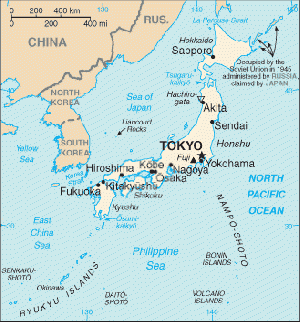Difference between revisions of "Hokkaido (Japan)"
GameoAdmin (talk | contribs) (CSV import - 20130820) |
GameoAdmin (talk | contribs) (CSV import - 20130823) |
||
| Line 1: | Line 1: | ||
| − | [[File:JapanMap.gif|300px|thumb|right|''Japan. World Factbook, 2006 | + | [[File:JapanMap.gif|300px|thumb|right|''Japan. World Factbook, 2006 '']] Hokkaido meaning "north-sea way," is the northernmost and second largest of Japan's four main islands. Although once a new frontier, it has become the largest prefecture in Japan, and ranks fifth in population. The capital is Sapporo (pop. 1,500,000 in 1987). A snow festival featuring huge snow sculptures is observed in that city every February. Several mountain ranges cross Hokkaido. Its total area is 83,513 sq. km. (32,236 sq. mi.), and its population in 1980 was about 5,576,000. The island has long winters and heavy snowfall, especially in the western portion. By contrast, summer in Hokkaido is warm and beautiful. The main agricultural crop is rice; grain, vegetables, and dairy farming flourish on broad plains. Fishing, forestry, and mining have long been an important part of Hokkaido's economy. Hokkaido is noted for its scenic national parks. They include hot springs, active volcanoes, deep lakes, and vast virgin forest. Black bears can be found. The island was originally inhabited by the <em>Ainu </em>(aborigines), but the majority of them were exploited and displaced by Japanese settlers in the latter half of the 19th century. The <em>Ainu </em>still exist in Hokkaido, but their language and culture are rapidly disappearing. |
| − | |||
| − | '']] Hokkaido meaning "north-sea way," is the northernmost and second largest of Japan's four main islands. Although once a new frontier, it has become the largest prefecture in Japan, and ranks fifth in population. The capital is Sapporo (pop. 1,500,000 in 1987). A snow festival featuring huge snow sculptures is observed in that city every February. Several mountain ranges cross Hokkaido. Its total area is 83,513 sq. km. (32,236 sq. mi.), and its population in 1980 was about 5,576,000. The island has long winters and heavy snowfall, especially in the western portion. By contrast, summer in Hokkaido is warm and beautiful. The main agricultural crop is rice; grain, vegetables, and dairy farming flourish on broad plains. Fishing, forestry, and mining have long been an important part of Hokkaido's economy. Hokkaido is noted for its scenic national parks. They include hot springs, active volcanoes, deep lakes, and vast virgin forest. Black bears can be found. The island was originally inhabited by the <em>Ainu </em>(aborigines), but the majority of them were exploited and displaced by Japanese settlers in the latter half of the 19th century. The <em>Ainu </em>still exist in Hokkaido, but their language and culture are rapidly disappearing. | ||
Many Americans feel the climate of Hokkaido resembles that of [[Minnesota (USA)|Minnesota]]. Winter sports abound, and the Winter Olympic Games have been held there. | Many Americans feel the climate of Hokkaido resembles that of [[Minnesota (USA)|Minnesota]]. Winter sports abound, and the Winter Olympic Games have been held there. | ||
Latest revision as of 14:03, 23 August 2013
Hokkaido meaning "north-sea way," is the northernmost and second largest of Japan's four main islands. Although once a new frontier, it has become the largest prefecture in Japan, and ranks fifth in population. The capital is Sapporo (pop. 1,500,000 in 1987). A snow festival featuring huge snow sculptures is observed in that city every February. Several mountain ranges cross Hokkaido. Its total area is 83,513 sq. km. (32,236 sq. mi.), and its population in 1980 was about 5,576,000. The island has long winters and heavy snowfall, especially in the western portion. By contrast, summer in Hokkaido is warm and beautiful. The main agricultural crop is rice; grain, vegetables, and dairy farming flourish on broad plains. Fishing, forestry, and mining have long been an important part of Hokkaido's economy. Hokkaido is noted for its scenic national parks. They include hot springs, active volcanoes, deep lakes, and vast virgin forest. Black bears can be found. The island was originally inhabited by the Ainu (aborigines), but the majority of them were exploited and displaced by Japanese settlers in the latter half of the 19th century. The Ainu still exist in Hokkaido, but their language and culture are rapidly disappearing.
Many Americans feel the climate of Hokkaido resembles that of Minnesota. Winter sports abound, and the Winter Olympic Games have been held there.
There were 17 Mennonite churches (Mennonite Church) on the island in 1987, organized into the Nihon Menonaito Kirisuto Kyokai Kyogikai (Japan Mennonite Church Conference). The work began in 1951. Except for Sapporo, the churches are all located in central and eastern Hokkaido. Besides Catholic (69) and Orthodox (8) churches, there are 34 Protestant denominations (302 churches) involved in mission on Hokkaido.
Bibliography
"Hokkaido." Kodansha Encyclopedia of Japan, vol. 3. Tokyo: Kodansha, 1983: 212-213.
Kraybill, Paul N., ed. Mennonite World Handbook. Lombard, IL: Mennonite World Conference, 1978: 174.
| Author(s) | Hiroshi Takahashi |
|---|---|
| Date Published | 1987 |
Cite This Article
MLA style
Takahashi, Hiroshi. "Hokkaido (Japan)." Global Anabaptist Mennonite Encyclopedia Online. 1987. Web. 16 Apr 2024. https://gameo.org/index.php?title=Hokkaido_(Japan)&oldid=92037.
APA style
Takahashi, Hiroshi. (1987). Hokkaido (Japan). Global Anabaptist Mennonite Encyclopedia Online. Retrieved 16 April 2024, from https://gameo.org/index.php?title=Hokkaido_(Japan)&oldid=92037.
Adapted by permission of Herald Press, Harrisonburg, Virginia, from Mennonite Encyclopedia, Vol. 5, p. 386. All rights reserved.
©1996-2024 by the Global Anabaptist Mennonite Encyclopedia Online. All rights reserved.

